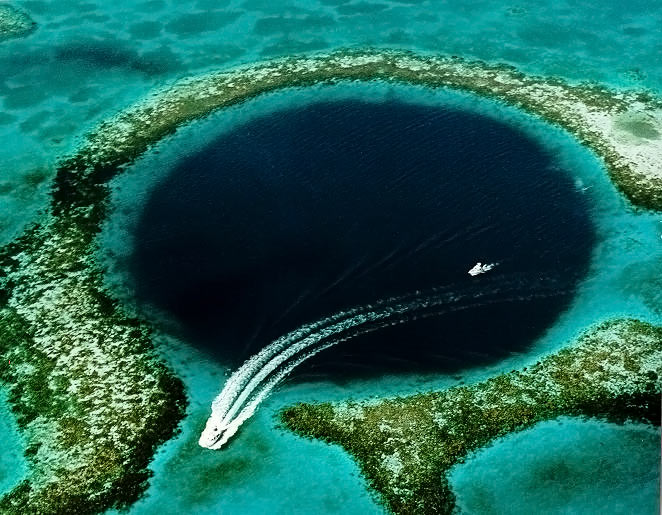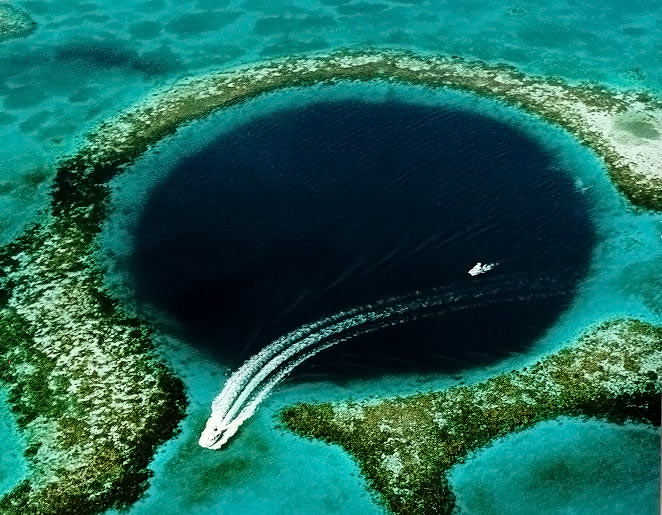The mechanisms of formation of a sinkhole involves natural process of erosion or gradual removal of slightly soluble bedrock (such as limestone) by percolating water, the collapse of a cave roof, or a lowering of the water table. This is how the massive underwater sinkhole in Belize called the Great Blue Hole was formed. One of the world’s most amazing geological formations and tourism spots around the world, weathering and erosion plays a major part in this. Water erosion specifically created this amazing spectacle that has produced tourism in the country of Belize. This is a perfect example of how weathering and erosion has benefit humans. I selected two articles on the Great Blue hole that pertain to my learning statement because of the way that it was formed and the way it benefits us.
BELIZE CITY, BELIZE
Great Blue Hole
A massive underwater sinkhole made famous by Jacques Cousteau.
The Great Blue Hole, located just 100 kilometers (60 miles) off the coast of Belize, is an underwater sinkhole that researchers believe is the largest of its kind.
Circular in shape and characterized by its rich, blue color, it is over 300 meters (984 ft) across and 125 meters (410 ft) deep. It lies in the center of an atoll called Lighthouse Reef, where an island of coral encircles the shallow, light turquoise-colored waters of a lagoon. Water levels there are so shallow that parts of the ring surrounding the dark blue sinkhole are even known to crest the surface at low tide.
The sinkhole originally formed as a limestone cave during the last glacial period, a time when sea levels were much lower. As the ocean began to rise, the cave system flooded and eventually collapsed, creating a “vertical cave” in the ocean. As such, the site is popular among divers, who flock to the area to see the geological formations that now lie in the ocean’s depths.
One such diver was undersea explorer Jacques Cousteau, who made the site famous in 1971 by declaring it one of the top ten best diving places in the world. At the time, Cousteau, sailing on his ship Calypso, investigated the sinkhole’s depths and confirmed that it had, indeed, originated from a limestone cave formation. Huge stalactites and stalagmites were also found below the surface, some even reaching 9-12 meters (30-40 ft) in length.
These geological formations can still be viewed by divers today. It is said that the deeper one goes, the water becomes more clear and the formations, more complex. The Great Blue Hole is part of the larger Belize Barrier Reef Reserve System, a World Heritage Site of the United Nations Educational, Scientific and Cultural Organization (UNESCO).
Great Belize Blue Hole

The Great Blue Hole is a world-class destination for recreational scuba divers attracted by the opportunity to dive in crystal-clear waters and see myriad species of marine life including tropical fish and spectacular coral formations.
The marine life in these areas includes nurse sharks, giant groupers, and several types of reef sharks such as the Caribbean reef shark and the Blacktip shark. Dive excursions to the Great Blue Hole are full-day trips, that usually consist of one dive in the Blue Hole and two additional dives in nearby reefs. The Great Blue Hole is in our list of Top 10 Reasons Why You Should Visit Belize.
The Great Blue Hole is a large underwater sinkhole off the coast of Belize. It lies near the center of Lighthouse Reef, a small atoll 100 kilometres (62 mi) from the mainland of Belize City.
The hole is circular in shape, over 300 metres (984 ft.) across and 125 metres (410 ft.) deep. The world’s largest natural formation of its kind, the Great Blue Hole is part of the larger Barrier Reef Reserve System, a World Heritage Site of the United Nations Educational, Scientific and Cultural Organization (UNESCO).
Glyn Collinson, a NASA scientist who recently dived the Great Blue Hole described it thus:
“It was the deepest, deep blue hole imaginable; A chasm that fell away deep into the deep, dark blue. It had been forged out of solid rock as caverns, hundreds of thousands of years ago during the last ice age. For eons, water filtered through the rock and into these great stone cathedrals, breeding multicolored stalactites and stalagmites. Then, one by one they collapsed in on each other, creating a chasm four hundred feet deep. As Earth’s swollen polar ice-caps receded, the warm Caribbean ocean swept in to fill the chasm with boiling white hands, the last rays of sunlight struck the chasm’s floor. Then, as the limestone broke down, it began to rain tiny fragments of rock, which slowly began to fill the great Blue Hole.”
“Alright,” the dive master said, jolting me back to reality. “Welcome to the Blue Hole. This one is real deep, starting with a drop off from forty feet that goes right the way down to the bottom past 400 feet.” The man held up a detailed custom drawn map of the site and pointed as he talked. “We will go down fast to one hundred and thirty feet where stalactites come down from this overhang. We will stay there for a maximum of twelve minutes, starting from the time that the first pair gets there. We all need to keep together and watch each other. To make sure that you all keep an eye on your depth, the dive pair who goes the deepest will buy a round of drinks for everyone back at the Island.” ‘Great’, I thought, ‘so much for pushing our depth limits.’
